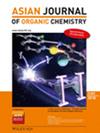Synthesis, DFT Calculations, and Molecular Docking Study of New Aggregation‐Induced Emission Lumiogens Based on Thieno[2,3‐d]pyrimidine Moiety
IF 2.8
4区 化学
Q1 CHEMISTRY, ORGANIC
引用次数: 0
Abstract
The discovery of novel Aggregation‐Induced Emission (AIE) systems based on heterocyclic compounds holds significant potential. In this study, a series of new AIE systems based on thieno[2,3‐d]pyrimidine moiety synthesized and characterized by spectroscopic analyses. These compounds exhibited weak emission in DMSO solution but displayed strong solid‐state fluorescence at λmax=556, 527, 527, and 515 nm for compounds 7 a, 7 b, 7 c, and 7 e respectively. Additionally, compound 10 exhibited emission at 480 nm in DMSO, which was red‐shifted to 490 nm in the solid state. Furthermore, the AIE behavior for these compounds was investigated in different DMSO/H2O fractions. Compounds 7 a–c, 7 e, and 10 exhibits a typical AIE behavior since these compounds showed weak fluorescence intensity in pure DMSO but sharply increased while the water content reached 80 % in the case of compounds 7 a–c, and 7 e, and 90 % in compound 10. Moreover, Density Functional Theory (DFT) calculations supported the role of molecular packing and intermolecular interactions in modulating the luminescence properties. Molecular docking studies suggested the potential of these AIE compounds as anticancer agents. Compound 7 a exhibits a strong binding affinity of −9.6 kcal/mol for CDK‐2 compared with abemaciclib, palbociclib, and ribociclib drugs, indicating its potential as a potent CDK‐2 inhibitor.
基于Thieno[2,3-d]嘧啶基团的新型聚集致发射发光物质的合成、DFT计算及分子对接研究
基于杂环化合物的新型聚集诱导发射(AIE)系统的发现具有重要的潜力。本研究合成了一系列基于噻吩[2,3-d]嘧啶片段的新型AIE体系,并用光谱分析对其进行了表征。化合物7a、7b、7c和7e在λmax=556、527、527和515 nm处表现出较强的固态荧光。此外,化合物10在DMSO中表现出480 nm的发光,在固态中红移到490 nm。此外,研究了这些化合物在不同DMSO/H2O馏分中的AIE行为。化合物7a - c、7e和10表现出典型的AIE行为,在纯DMSO中荧光强度较弱,但当化合物7a - c和7e的含水量达到80%,化合物10达到90%时荧光强度急剧增加。此外,密度泛函理论(DFT)计算支持分子堆积和分子间相互作用在调节发光特性中的作用。分子对接研究表明,这些AIE化合物具有抗癌潜力。与abemaciclib、palbociclib和ribociclib药物相比,化合物7a对CDK-2表现出−9.6 kcal/mol的强结合亲和力,表明其可能是一种有效的CDK-2抑制剂。
本文章由计算机程序翻译,如有差异,请以英文原文为准。
求助全文
约1分钟内获得全文
求助全文
来源期刊

Asian Journal of Organic Chemistry
CHEMISTRY, ORGANIC-
CiteScore
4.70
自引率
3.70%
发文量
372
期刊介绍:
Organic chemistry is the fundamental science that stands at the heart of chemistry, biology, and materials science. Research in these areas is vigorous and truly international, with three major regions making almost equal contributions: America, Europe and Asia. Asia now has its own top international organic chemistry journal—the Asian Journal of Organic Chemistry (AsianJOC)
The AsianJOC is designed to be a top-ranked international research journal and publishes primary research as well as critical secondary information from authors across the world. The journal covers organic chemistry in its entirety. Authors and readers come from academia, the chemical industry, and government laboratories.
 求助内容:
求助内容: 应助结果提醒方式:
应助结果提醒方式:


